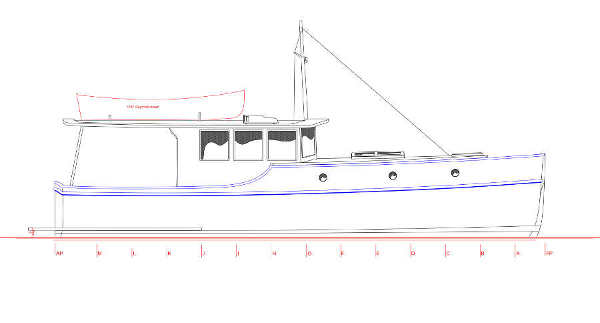Yellow Cedar, 34' Classic Motor Yacht
About the Plans
-
Construction Method and Materials:
Number and Type of Drawings:
Study Plan:
General Arrangement PDFStudy Plan:
Sail Plan PDFDesign Comments:
Design CommentsBase Price:
$ CAD
Similar Designs
Designer's Comments

The Yellow Cedar 34 is a 20 year update on my earlier Yellow Cedar 38’, drawn back in illustrate a WoodenBoat article on powerboat design. The style is almost generic to the Pacific Northwest, gaining popularity in the 1920’s with the Lake Union Dreamboats, designed by Leigh Coolidge and built by Blanchard and Lake Union Drydock. These are very much protected water cruisers, many have been north from Puget Sound into the Alaskan Panhandle, but they are not open ocean cruisers. In many ways the popularity of the type stems from the practical arrangement. Here in the NW it rains a lot, and it’s cool even on summer evenings, so protection is appreciated year round. With the aft cockpit enclosed by weather curtains under the hard-top, the deck saloon of the YC34 is 14’6” x 7’6”. The raised foredeck is simple to build, strong, and roomy both inside and on deck. I have included a small well deck right forward as a handy spot to store anchors, rope, fenders, etc. Construction is intended to be upside down. The laminated frames are made up with their floors and set up on a strongback with the stem and transom. Then the apron (inner keel) is laminated in place and planking can begin. Once the planking is complete and faired, the outer keel and stem are installed, along with the bilge keels if wanted, and the entire structure is sheathed in fiberglass. Then it can be faired again and primed before flipping upright for completion.
The popularity of the type today stems, I believe, from the practical arrangement, her timeless good looks, and the perceived efficiency of the light, full-displacement hull form. The downside of this type, with round bilge and narrow beam, is the tendency to roll and keep on rolling. In the traditional form there is nothing besides the keel to damp rolling. So if one wanted this boat for open water coastwise cruising, I would add a pair of bilge keels aft. They should run from station H to station L at the root, about 12” tall and positioned well outboard and square off the hull bottom, with tapered leading and trailing edges, and made up of stacked timber about 2.5” thick at the root and thinner at the tip. They would be fiberglassed and reinforced with threaded rod set in epoxy, and bolted to doubler pads inside the hull planking.
It takes very little power to push this hull at low speed. Intended cruising speed is 6.5-7 knots with the little (2L) four cylinder Beta turning 16-1800 RPM in flat water. At this speed fuel consumption will be less than 3⁄4 of a US gallon per hour. She might just manage 8 knots with the engine wide open (2800 RPM). If she were my boat I would install outside copper keel cooling pipes and a dry exhaust running up in the aft starboard corner of the pilothouse. But most folks object to soot on the dinghy and cabintop and so will have a wet exhaust out the transom. Even then I would add another (salt) water pump and stick with the keel cooler. The most common problem with diesel engines (after bad fuel) is cooling related, and there’s just too much junk in the water to chance sucking something nasty into the cooling system. Engine air intakes are under the step P&S aft of the side deck break. Hot air is ducted out aft to clamshells on top of the transom. Tankage for 100 usg of fuel is in aluminum tanks p&s of the engine, and two plastic water tanks of 30 usg each are aft of that.
The boat is designed to be used by four people comfortably, but more can be accommodated on the cabin and cockpit sole. With the bow double, galley single,and deckhouse single, there is some division of space for privacy. Both the single berths could be expanded (pulled out) into doubles. A swim step is fitted but I would highly recommend foregoing the expected transom door. Just fit a couple of steps on the outside of the transom and climb over. The door weakens the structure and offers a number of possible rot pockets, it’s just not worth it.

